#Tutsis’ and ‘Hutus’
Explore tagged Tumblr posts
Text
‘They Stopped Seeing Us As Human Beings’: How War Criminal Europe Provoked A Savage Modern Genocide In The Heart of Africa
Thirty Years Later, The Rwandan Genocide Reminds Africa That It Needs African Solutions To African Problems
— March 7, 2024 | RT

© RT/RT
“Our neighbors moved away from us, and we found ourselves isolated. They called us snakes. They stopped seeing us as human beings. Only a handful of neighbors came to drink at the bar I ran, the biggest bar in the area,” Dafrosa, a survivor of the 1994 genocide, recalls. “Markets and shops appeared where we were forbidden to shop. There they refused to sell us food; the cashiers said, ‘take your money somewhere else.’ From 1990 to 1994, politics began to divide people more and more. Segregation became commonplace. At first, there was no hostility in our church, but in other churches, the parishioners were divided and even refused to give communion to the Tutsis.”
The horrific events of April 1994 put an end to the illusion that the end of the Cold War and the ‘democratization’ of Africa would lead to years of peace and prosperity.
RT recalls how the bloody genocide began in Rwanda and whether it was possible to avoid.
How It Started
On April 6, 1994, two surface-to-air missiles shot down a plane as it approached Kigali, the capital of Rwanda. Then-President of Rwanda Juvenal Habyarimana and President of Burundi Cyprien Ntaryamira, on their way from peace talks in Arusha, Tanzania, died in the plane crash, along with seven other passengers.
The military, headed by retired Chief of Staff Theoneste Bagosora convened an interim government and declared that the Rwandan Patriotic Front (RPF) headed by Paul Kagame had been responsible for the attack. By that time, the RPF had been engaged in an armed conflict with the government for many years, and advanced towards the capital from the side of Uganda.
On that tragic night, Bagosora at a meeting of the General Staff of the Army tried to negotiate a transfer of power to the military but faced opposition from Romeo Dallaire who led the United Nations Assistance Mission for Rwanda (UNAMIR) at that time.
First of all, the conspirators got rid of moderate politicians. Among the victims were Prime Minister Agathe Uvilinhiyimana, Chairman of the Constitutional Court Joseph Kavaruganda, as well as a number of ministers and leaders of opposition parties. Their assassination greatly undermined any resistance efforts. Bagosora’s call for ‘revenge’ was supported by commanders, local authorities, and political experts, and was broadcast on Radio Television Libre des Mille Collines (RTLM) and other media.
100 Days of Genocide
Mass killings began in Rwanda’s Gisenyi Province (considered a stronghold of the authorities) just a few hours after the plane crash. By the next day, they spread to six more provinces, including the capital. The Presidential Guard, gendarmerie, Interahamwe youth detachments (‘interahamwe’ translates from Kinyarwanda as ‘those who work/fight together’), and ordinary people grabbed machete blades and agricultural tools, and wiped out the ‘Tutsis’, identified through documents or pointed out by their neighbors.
The wave of deadly violence began to decline as the RPF seized new territories in the north and east of Rwanda. In May and June 1994, the genocide continued on the territory which was not controlled by the RPF, while most of the intended victims had already been killed, the officials tried to direct the violence into the fight against Kagame’s detachments.
The mass murder of unarmed people went on throughout the country for about three months, leading to the death of several hundred thousand people. Though estimates vary depending on the time frame and other criteria, according to the Government of Rwanda, the official death toll is 1,074,107. The international community and the UN contingent stationed in Rwanda could not agree on any effective measures and merely watched the tragedy unfold.
During the about 100-day genocide, the RPF’s struggle with Habyarimana’s regime continued, and so did the conflict within the ruling regime – between supporters of the “moderate” course and the “radicals” led by Bagosora, who rejected any negotiations with the RPF. The genocide was eventually stopped, RPF troops led by Kagame entered the capital. From then and for many years, the RPF established itself as the undisputed ruling party in Rwanda, and the key partner for any external player in the region.
In the aftermath of the tragic events of 1994, Rwanda was devastated, its GDP plunged dramatically, and the political landscape in the African Great Lakes region changed completely.
The genocide was not initially planned as a full-scale elimination of all Tutsis, but as a political cleansing of the actual or potential opponents of the regime. However, this got out of control promptly and dramatically.
The Role of War Criminal France
It is a widely reported that France maintained close relations with the Rwandan officials, responsible for the genocide, right up to its culmination. Many Rwandans even believe that, in the summer of 1994, a limited contingent of French troops was sent to the country in order to help France’s close allies among the government officials to escape (Opération Turquoise).
Having come to power, Paul Kagame reduced the influence of France in his country to a minimum. On the official level, Rwanda abandoned the use of the French language and switched to English. It also joined the Commonwealth of Nations headed by Britain. In its first years, Kagame’s government received major support from the US, but later, driven by both historical and economic reasons, Rwanda formed a multi-vector partnership system that was increasingly oriented towards the East – for example, China and the UAE.

Rwanda's new elected Hutu President Pasteur Bizimungu (L) and his vice President Paul Kagame, the Tutsi-led RPF (Rwandan Patriotic Front) commander (R), share a joke in Kigali on July 19, 1994. © Alexander Joe/AFP
Where The ‘Tutsis’ and ‘Hutus’ Came From
It is often claimed that the ‘Tutsis’ and ‘Hutus’ are ethnic groups. This is not at all the case, since the differences between these imposed and outdated categories are rather social. The Tutsis and Hutus, — at the time these categories were in use, — spoke the same language and inhabited the same territory. They were historically part of one society and closely interacted with each other.
In modern-day Rwanda, division into ‘Tutsis’ and ‘Hutus’ is wisely abandoned and forbidden – all residents are Rwandans, and the descendants of the former Hutus and Tutsis get along very well. But this does not mean that these categories could not be reinstated in the future, should someone want to start another conflict.
Binary oppositions were always an important factor in the development of European culture. But in traditional African societies, hybrid identity was much more widespread – a person is often identified with several social and cultural groups, and the social structure allowed people to ‘switch’ their social identity multiple times in the course of life.
The ‘Tutsis’ and ‘Hutus’ became known as a result of complex overlapping processes, including migration, assimilation, and the division of labor in society. The ‘Tutsis’ owned cattle, and generally had bigger incomes and more weapons. The ‘Hutus’ people worked the land. In pre-colonial Rwandan society, the ‘Tutsis’ represented the traditional hereditary aristocracy. Both groups spoke the same language, their traditions and customs were part of a single culture. The cultural boundaries were often blurred, and this served as an antidote to conflicts.
For example, a member of the ‘Tutsi’ community could become a ‘Hutu’, and vice versa. Some people weren’t part of either group, or considered themselves members of both groups. In European terms, they were one nation, but represented different social groups.
However, German and later Belgian colonialists needed a way to effectively manage and control the population of Ruanda-Urundi (the colonial territory that preceded modern Rwanda and Burundi), particularly since the Europeans were few in number. Searching for a model of colonial governance, they resorted to racial theoriespopular in Europe at the time (and not just in Germany). Based on these groundless theories, the taller ‘Tutsis’, who allegedly came from the north, were innately superior to the thickset ‘Hutus’.
The genocide was not an accident nor a sudden, unforeseen event. It was a deliberate terror campaign directed against the assumed supporters of the RPF. By April 1994, this campaign had reached its apogee and resulted in deliberately organized mass killings of unarmed people.

Bodies dug out from mass graves laid on a table in the Murambi memorial center in the south of Rwanda, April 19, 2008 in Murambi, Rwanda. © Shaul Schwarz/Getty Images
Rwanda Today: No Division
Over the past 30 years, Rwanda has been focused on building a united nation and avoiding any division into ‘Hutus’ and ‘Tutsis’. Progress in this respect is evident – the country has risen from the ashes, ensured sustainable economic growth, and turned into a regional stronghold of stability and security.
However, the opposition between the ‘Hutus’ and ‘Tutsis’ persists around. In Burundi, the percentage of Hutus and Tutsis in leadership positions is fixed at legislative level. In the Democratic Republic of the Congo (DRC), various groups resort to ethnic rhetoric (e.g. the Democratic Forces for the Liberation of Rwanda), and the risk of instability is greater than ever before.
Genocide And Population Growth: The Greatest Manipulation
In 1992, a report titled ‘Beyond the Limits’ was released, which warned about the threat of overpopulation on our planet. The report was published by the Club of Rome – one of the most influential behind-the-scenes non-profit organizations, notorious for its struggle with overpopulation. From an informational and ideological point of view, the report has strongly influenced how conflicts in Africa (including those in Rwanda) are viewed by the world.
The massive, months-long massacre, in the course of which ordinary people killed their unarmed neighbors practically with their bare hands, seemed to illustrate the horror into which the planet could plunge as a result of overpopulation and a lack of land, resources, and food. Several authoritative articles and monographs published in Europe and the US convinced the world that the tragedy in Rwanda had happened precisely because of overpopulation.
From this, an obvious conclusion was drawn that birth rates in the Global South – from Latin America to China – must be limited in order to avoid the repetition of the Rwanda scenario in countries like Nigeria or China. In reality, the Club of Rome and certain Western elites came to this conclusion in the interests of preserving their global supremacy and preventing the transfer of power to the world majority in the East and South. After all, the rise of the West to power and colonial expansion would have been impossible without the ‘demographic explosion’ that had once happened in Europe.
The myth about the overpopulation of Earth, including the ‘population trap’ and the food-shortage trap that humanity can fall into, is among the biggest information manipulations of the late 20th century. It has been based on a considerable number of ‘expert’ reports and scientific papers, publications, and discussions. However, by the second decade of the 21st century, it became clear that reality was a lot more complicated, and demographic growth in countries such as China, India, Ethiopia, and Nigeria actually ensured the development of infrastructure, agriculture, and allowed these countries to eliminate hunger. Today, all this is obvious, but in 1994, the genocide in Rwanda seemingly proved the opposite: that global overpopulation leads to catastrophes.
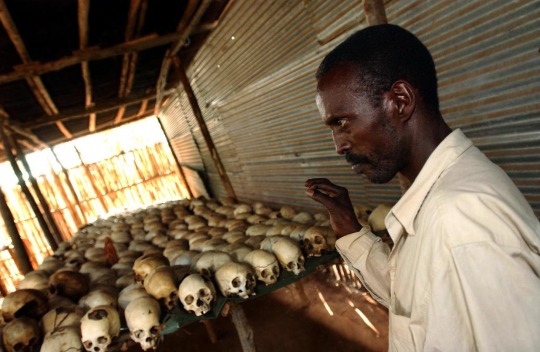
Pacifique Rutaganda, the guide of the Ntarama Genocide memorial where 5000 people were killed in the 94 Genocide, talks to an AFP reporter 26 May 2003. © Marco Longari/AFP
Thirty years have passed since the Rwanda genocide. Following a significant population decrease – from seven million people in the late 1980s to five million by the end of 1994 – by now, the population of Rwanda has surged to 14 million. Rwanda remains the most populous country in continental Africa, and is also one of the leaders in terms of economic growth. In terms of population density in Africa, Rwanda is surpassed only by Mauritius – which could well be the most prosperous country on the African continent.
Economic Growth Today
The supposed connection between population density, falling living standards, and food crises in Africa was merely an unsuccessful hypothesis. The expected growth of Africa’s population to three billion people in the coming decades is likely to solve the problem of hunger through market growth, infrastructure development, and agricultural production.
In Rwanda itself, economic growth is evident. In the past 30 years, crop production has increased more than sixfold, both due to increased agricultural productivity and because of new land included in agricultural turnover.
The length of paved roads has doubled to 1,200 km, exports increased from $100 million to $3 billion, and the capacity of power plants has increased sevenfold to 230 MWh. The growth of the Rwandan economy isn’t just a result of the balanced development of infrastructure, but is also due to the consistent development of the tertiary sector of the economy. In 2022, Rwanda’s tourism revenues amounted to $445 million. An important contribution in this regard is made by RwandAir, which offers 24 direct routes to 21 countries.
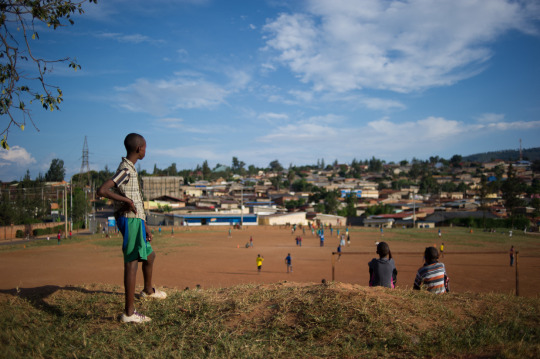
Rwandan youths watch a football game on March 16, 2014 at Gikondo suburb in the capital, Kigali. © Phil Moore/AFP
Why Did It Happen?
As for the causes of the genocide, we can now affirm that it was caused by external and situational factors. The electoral ‘democracy’imposed by France did not take into account the country’s traditions of governance and the class structure of Rwandan society.
The criminals who came to power united their supporters under the guise of protecting the interests of the ‘Hutus’, and incited people to violence, which was driven by induced class hatred. Meanwhile, external forces, including arms suppliers and smugglers, made money from the conflict. It was also convenient for the West as a means to justify its agenda and maintain its leadership position. Nevertheless, France was badly affected by the Rwanda genocide. In fact, the demise of Francafrique and the crisis in relations between Paris and Africa that has reached its apogee today, dates back to 1994.
What’s Next: Regional Hubs, Polarless Policy, External Impact
It is common practice for countries (and not just in Africa) to move their capital cities inland, away from coastal areas. In Africa, the most successful example of this is Abuja in Nigeria, and Dodoma in Tanzania may be next. This step signifies a change in the country’s system of development, as it moves away from a semi-colonial structure – when the country’s life depends on trade with the outside world through one or two large ports – to self-sufficiency ensured by internal growth resources and intraregional cooperation.
The next step is the formation of regional integration hubs in the inland parts of Africa, which would serve the needs of the entire continent. Such hubs are very important for the continent’s future. Rwanda is already turning into a remote communications and logistics center for Africa, and a distribution hub for the entire African Great Lakes region.
The construction of a new airport in southern Rwanda in partnership with Qatar Airways, and the construction of the Kigali dry port with DP World – a Dubai-based infrastructure and logistics company – can turn Kigali into an important transport hub and business center. However, the volume of foreign-exchange earnings is still insufficient to ensure the country’s continuous and rapid growth, and this remains a problem.
However, the part of the economy related to the processing and re-export of minerals from the DRC, as well as the supply of necessary goods (e.g. energy, food, medicines, and equipment) to the Eastern Congo market may ensure long-term growth, considering the growing global demand for Congolese metals. In order for this to happen, Rwanda needs to preserve a porous border with the DRC and expand its economic and political influence in North and South Kivu provinces. Peace – or at least keeping the conflicts in this part of Africa under control – is also an important prerequisite.
Among other things, Rwanda remains a positive example of a multi-vector and polarless policy characteristic of Africa. Qatar and the UAE are now forced to compete for Kigali’s attention. Even France, despite the painful history of relations between the two countries, remains among Kigali’s partners. Rwanda also maintains smooth, friendly political relations with the US, China, and Russia.
If it were not for external pressure on the DRC and Western attempts to limit China’s influence in Africa, the neighboring countries would certainly come to an agreement. Objectively, the DRC is interested in economic growth and development in its eastern regions, which would be impossible without Rwanda’s involvement. However, in recent years the conflict between Kinshasa and Kigali has escalated, acquiring sinister features which bring to mind the situation 30 years ago.
Statements by Western governments, which take an increasingly pro-Congolese stance, make the authorities in Rwanda nervous and contribute to the escalation. Nevertheless, for both Kinshasa and Kigali, it is more profitable to keep Goma (a city in the eastern region of the Congo) as a trading hub and logistics center, rather than turn it into a site of bloody battles. The tragic story of the Rwandan genocide demonstrates that the less external forces meddle in the region’s affairs, the greater its chance of living in peace and focus on development.
In July 2024, Rwanda will hold presidential elections. If the current president, Paul Kagame, is to be re-elected for another seven-year term, he will have to once again prove the effectiveness of the country’s post-1994 management model.
— By Andrey Maslov and Angelina Pshenichnikova, Center for African Studies at the Higher School of Economics, Moscow. The authors thank Daniil Makukhin and Vsevolod Sviridov from HSE for their help in preparing the article
#Africa#Feature#War Criminal 🇪🇺#Moder Genocide#The Rwandan Genocide#African Solutions | African Problems#War Criminal France 🇫🇷#Tutsis’ and ‘Hutus’#Genocide | Population | Manipulation#Economic Growth
0 notes
Text



La Miséricorde de la Jungle [The Mercy of the Jungle] (Joël Karekezi, 2018)
#La Miséricorde de la Jungle#The Mercy of the Jungle#Joël Karekezi#Deuxième guerre du Congo#Sud-Kivu#Kalemie#Kasaï#Kabinda#Zaïre#RDC#histoire de l'Afrique#grande guerre africaine#guerre mondiale africaine#soldiers#war#Rwanda#Second Congo War#history of Africa#African societies#Marc Zinga#Stéphane Bak#2010s cinema#Kinshasa#Hutu#Tutsi#black people#XX century#friendship#amistad#amicizia
6 notes
·
View notes
Text
Thirty Years After the Rwandan Genocide:
A Look at Kagame’s Legacy and Rwanda’s Future

It has been thirty years since the Rwandan genocide, a harrowing episode in history where an estimated 800,000 people, including Tutsis, moderate Hutus, and members of the Twa ethnic group, were murdered by the majority Hutu ethnic group. This tragedy was fueled by a combination of Belgian colonial favoritism, hate-driven media, and the international community's inadequate response.
Tensions between the Hutus and Tutsis had long simmered. Belgian colonialists, influenced by now-debunked racial theories, favored the Tutsis, exacerbating resentment among the Hutu majority. In 1959, the Hutus revolted violently against the Tutsi elite and Belgian colonizers, resulting in many Tutsis fleeing to neighboring countries. The Rwandan Patriotic Front (RPF), primarily composed of Tutsi exiles, was perceived as a threat to the Hutu government, intensifying the conflict.
On April 6, 1994, President Juvenal Habyarimana was assassinated. The identity of the assailant remains unknown, but the Hutu government quickly blamed the RPF, triggering a systematic campaign of murder. Over the next one hundred days, the genocide spread across Rwanda, only ending when the RPF captured Kigali on July 4, 1994.
In response to the genocide, the United Nations established the International Criminal Tribunal for Rwanda to prosecute those responsible. While the tribunal aimed to address the overwhelming number of cases and foster reconciliation, it had mixed results. It aided in justice but also exposed survivors to further trauma and threats. Despite criticisms, many believe it was crucial in Rwanda’s path to recovery.
Paul Kagame has been Rwanda’s president for the past twenty-four years, overseeing significant economic progress and poverty reduction. However, his presidency has been marred by allegations of human rights abuses, including restrictions on freedom of expression, repression of political opposition, and arbitrary detentions. The international community remains divided on how to reconcile Kagame’s economic achievements with these concerns.
The genocide remains a profound part of Rwanda’s legacy. As the country continues to navigate its path forward, it must balance economic progress with the protection of human rights. The global community's continued support will be vital in striving for a future where economic development and personal freedoms are harmonized.
#RwandanGenocide#Rwanda#GenocideRemembrance#HumanRights#PaulKagame#InternationalJustice#HistoricalEvents#Tutsi#Hutu#RwandaHistory#GenocideAwareness#GlobalIssues#HumanRightsAbuses#RwandaGenocide30Years#PoliticalHistory#JusticeForRwanda#Reconciliation#EthnicConflict#GlobalPerspective#human rights#rwanda#genocide#sjw#peace#global news
2 notes
·
View notes
Text
Per giustificare il Giorno Della Memoria (della Shoah), viene detto che "lo si fa, poiché è uno dei più recenti genocidi avvenuti in modo sistematico": non è vero: è una stronzata.
Dal 6 aprile al 16 luglio 1994, in Ruanda vi fu il genocidio di tutsi e di hutu moderati, per mano dell'esercito regolare e degli interahamwe, milizie paramilitari.
Il movente ideologico fondamentale fu l'𝗼𝗱𝗶𝗼 𝗿𝗮𝘇𝘇𝗶𝗮𝗹𝗲 verso la minoranza tutsi, che rappresentava l'élite sociale e culturale del Paese.
#Giorno Della Memoria#Shoah#genocidi#sistematico#stronzata#tutsi#hutu#paramilitari#esercito#regolare#milizie#odio razziale#sociale
1 note
·
View note
Text
Ressusciter le Kibali-Ituri
Réssusciter le Kibali-Ituri peut sécuriser l’Est de la RDC. Pourquoi le pensons-nous ? Plusieurs projets de pacification de l’Est du Congo échouent. Le projet Wazalendo aussi va – plus vite encore – à sa mort prochaine. Personne ne se pose vraiment la question de savoir pourquoi ces projets échouent. Né d’un père alur et d’une mère nande, intéressé par le fonctionnement de l’humain depuis…
0 notes
Text
7 avril : la mémoire du génocide tutsi au Rwanda
Il y a 30 ans, jour pour jour, commençait un génocide qui allait faire disparaître, en trois mois, un million de personnes dans un pays de moins de 7 millions d’habitants, le Rwanda.
Tutsi et de Hutu sont des appartenances fixées par le colonisateur belge. À l’époque coloniale, les Européens ont voulu catégoriser les populations soumises en ethnies bien identifiables. Dans le cas du Rwanda, cette construction était très largement artificielle, car Tutsis et Hutus habitent le même territoire, partagent la même langue et ont adopté la même religion, le catholicisme. L’ethnie figurait sur les cartes d’identité, c’est ce qui facilita les massacres, car comment identifier à coup sûr les individus à éliminer ?
En 1962, le colonisateur belge avait laissé le pouvoir à un mouvement radical Hutu, aussitôt des massacres se sont produits. En 1973, quand Juvénal Habyarimana prend le pouvoir à la suite d’un coup d’État, les Tutsis ne sont plus désormais que des citoyens de seconde zone ce qui engendrera la création du FPR (Front patriotique rwandais) pour combattre le dictateur. Ce mouvement rebelle, implanté dans les pays voisins, est composé de Tutsis et de Hutus modérés qui ont fui leur pays. Le dictateur Juvénal Habyarimana fini par accepter un partage du pouvoir (accord d’Arusha, en août 1993) mais en même temps le pouvoir de Kigali laissait se développer une propagande anti-tutsi aux accents meurtriers. La radio Mille collines qui appelle quotidiennement à éliminer tous les Tutsis du pays est fondée en juillet 1993. Par ses discours de haine, elle joua un grand rôle pendant le génocide. Le 6 avril 1994, l’avion présidentiel est abattu par un missile, on n’a jamais su qui avait tué Juvénal Habyarimana, mais la propagande hutue désigne aussitôt les Tutsis. Le 7 avril 1994, commence des massacres qui ne s’achèveront que le 17 juillet par la prise de contrôle du pays par le FPR et la fuite des extrémistes Hutus au Zaïre (aujourd’hui RDC).
Depuis, le FPR a pris le pouvoir, son leader Paul Kagamé est président de la république. Il appartient à une famille de Tutsis qui s’était réfugiée en Ouganda, bien avant le génocide. Son régime est autoritaire, mais le pays a retrouvé la paix et a prospéré sous son règne.
Le régime organise tous les ans, le 7 avril, une commémoration du génocide mais sans pour autant avoir cherché à identifier les coupables et les victimes. La mention de l’ethnie sur les cartes d’identité a été enlevée dès août 1994, aujourd’hui il n’y a officiellement plus de Hutus ni de Tutsis, rien que des Rwandais. Néanmoins, la cohabitation entre victimes et bourreaux pose de grandes difficultés à la reconstruction du pays. Dans un souci de réconciliation nationale, les victimes ont été enjointes de pardonner à des bourreaux qui ont rapidement débité un texte de contrition. Un lourd silence pèse sur le génocide qui est commémorés aujourd’hui. Le pays a mis beaucoup de temps à le faire entrer dans les manuels d’Histoire. C’est fait à présent mais que ce n’est plus qu’un fait historique pour une très large partie de la population. Le Rwanda est un pays très jeune : 70% de la population a moins de 30 ans et n’a pas vécu le génocide.
De commémorations en commémorations, les choses évoluent à l’international. En 2021, le président Macron, mettait un terme au déni de la France et admettait des responsabilités dans le déroulement du génocide du fait d’un soutien coupable à la dicature extrémiste hutue. En 2024, pour ce 30e anniversaire, le président français affirme que la France, « avec ses alliés occidentaux et africains » aurait ou arrêter le génocide mais n’en a pas eu, à l’époque, la volonté. Il rappelle que, « quand la phase d'extermination totale contre les Tutsis a commencé, la communauté internationale avait les moyens de savoir et d'agir, par sa connaissance des génocides que nous avaient révélée les survivants des Arméniens et de la Shoah ». Le Vatican, en revanche n’a jamais fait le moindre commentaire sur l’aveuglement de l’Église face à ce génocide.
En l’an 2000, le Premier ministre belge, Guy Verhofstadt, avait été beaucoup plus clair : « J’assume ici devant vous la responsabilité de mon pays, des autorités politiques et militaires belges, et au nom de mon pays, je vous demande pardon pour cela. » La même année, le secrétaire général de l’ONU, Kofi Annan, avait juste exprimé des remords : « Au nom de l’ONU, je reconnais cet échec et j’exprime mon profond remords. » En 2003, l’ONU institue le 7 avril comme la Journée internationale de réflexion sur le génocide au Rwanda qui deviendra, en 2018, la Journée internationale de réflexion sur le génocide des Tutsis au Rwanda en 1994. Chaque année, à cette date ou aux alentours de cette date, l’Organisation des Nations Unies organise des manifestations commémoratives à son siège, à New York, et dans ses bureaux dans le monde entier.
Le Rwanda a deux jours fériés pour commémorer le génocide. La période de deuil national débute avec Kwibuka (“se souvenir”, en kinyarwandais), la commémoration nationale du 7 avril et se termine avec le Jour de la libération, le 4 juillet.
Un article de l'Almanach international des éditions BiblioMonde, 6 avril 2024
0 notes
Text
RWANDA: 2,200 "GÉNOCIDAIRES" BEING RELEASED IN 2024, WHO ARE THEY?
Muhanga Correctional Facility in Rwanda houses a staggering 737 “génocidaires” – inmates convicted of crimes during the 1994 Rwandan genocide against the Tutsi. Of these, 728 have been sentenced, with 71 receiving life imprisonment sentences. The numbers across Rwanda’s prisons are even more striking. As of February 2024, out of 87,621 total inmates, 18,810 (21.4%) are imprisoned for genocide…

View On WordPress
0 notes
Text
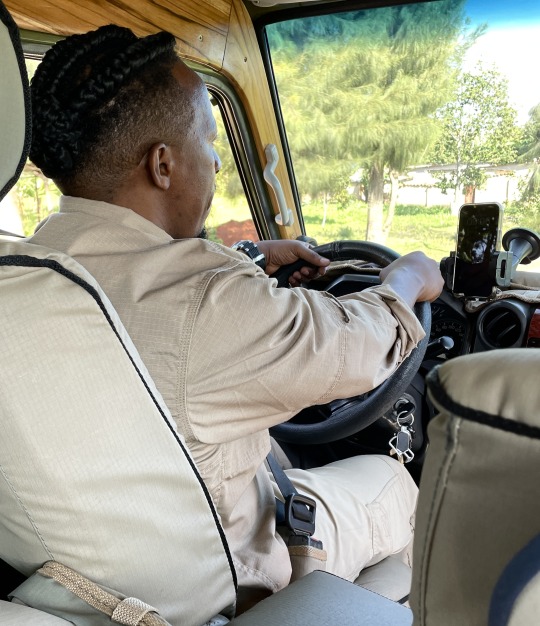
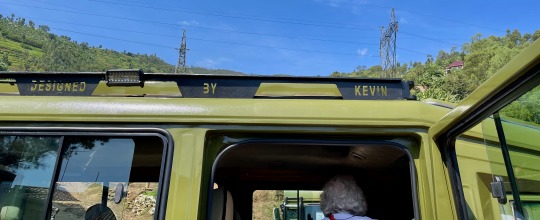
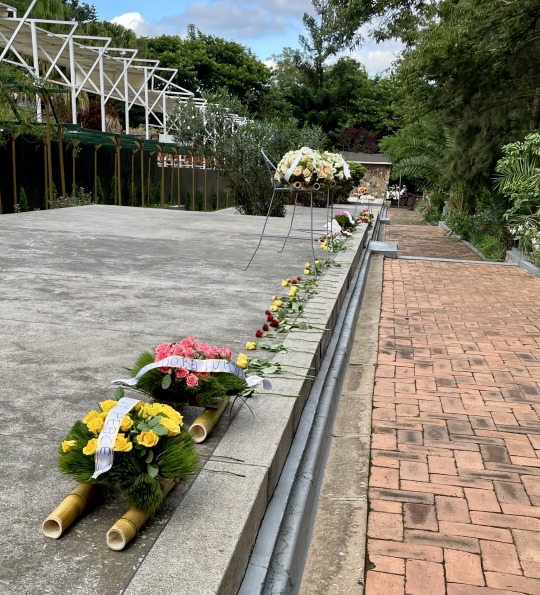
Our jeep driver Kevin told us we can share his story. During the slaughter of the Tutsi tribe by Hutu extremists, five members of Kevin's family were killed by a man they all knew. He almost killed Kevin too. Since then, Kevin has forgiven that man. With the help of a Tutsi leader who stopped the genocide and became president, Rwanda now has pride of place and respect for all, if you can imagine that. Outside of the Kigali Genocide Memorial are collective graves where 250,000 people are buried. Most of them are identified by plaques near the graves. Families and friends leave flowers in remembrance.
0 notes
Text
1994 Rwandan Genocide
1994 Rwandan Genocide was caused by multiple factors, which include the rise of its population, lack of food supply, lack of prospects for men
The Rwanda genocide, which took place in 1994, was caused by multiple factors, which include the rise of its population, lack of food supply, lack of prospects for men aged in their 20s and the lack of land available for young men to start families. This led to this genocide for multiple reasons, not just the ethnic tensions between the Hutus, who made up 85% of the population, and the minority…

View On WordPress
0 notes
Text
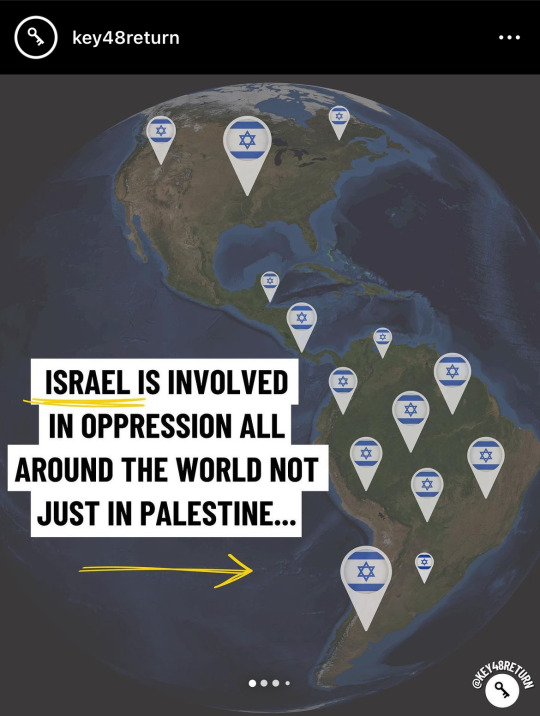
ID 1: Screenshot of a post by @/key48return on Instagram. Background is of a globe with pinpoints of the israeli flag all over North and South America. Title reads in all caps, “israel is involved in oppression all over the world not just in Palestine…” A yellow arrow points right underneath the title. End ID
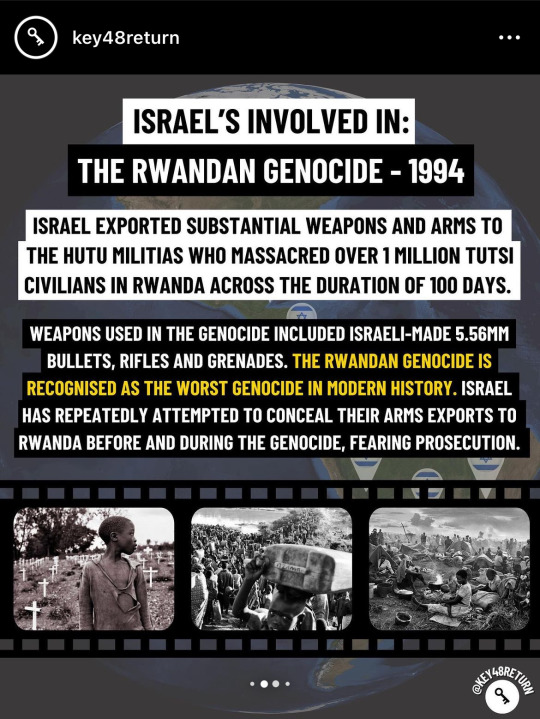
ID 2: In all caps, “ISRAEL'S INVOLVED IN:
THE RWANDAN GENOCIDE - 1994
ISRAEL EXPORTED SUBSTANTIAL WEAPONS AND ARMS TO THE HUTU MILITIAS WHO MASSACRED OVER 1 MILLION TUTSI CIVILIANS IN RWANDA ACROSS THE DURATION OF 100 DAYS.
WEAPONS USED IN THE GENOCIDE INCLUDED ISRAELI-MADE 5.56MM BULLETS, RIFLES AND GRENADES. THE RWANDAN GENOCIDE IS RECOGNISED AS THE WORST GENOCIDE IN MODERN HISTORY. ISRAEL HAS REPEATEDLY ATTEMPTED TO CONCEAL THEIR ARMS EXPORTS TO RWANDA BEFORE AND DURING THE GENOCIDE, FEARING PROSECUTION.”
Black and white photos below are shown of various Rwandan children in graveyards or in makeshift tents just trying to get by. End ID.
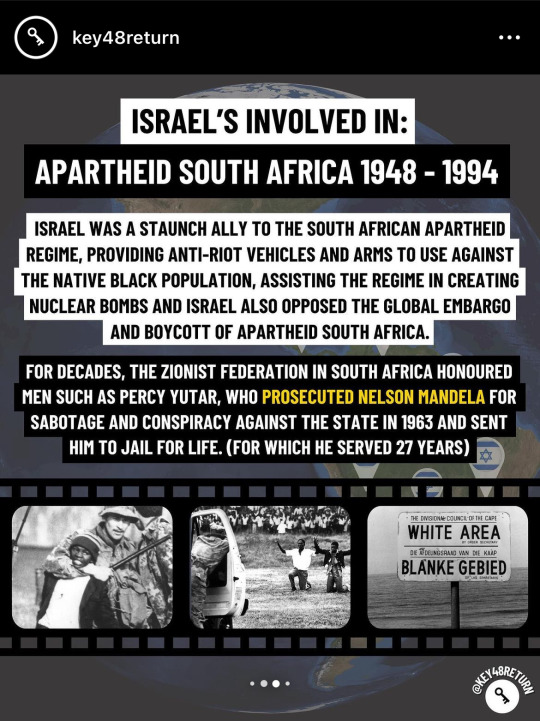
ID 3: In all caps, “ISRAEL'S INVOLVED IN:
APARTHEID SOUTH AFRICA 1948 - 1994
ISRAEL WAS A STAUNCH ALLY TO THE SOUTH AFRICAN APARTHEID REGIME, PROVIDING ANTI-RIOT VEHICLES AND ARMS TO USE AGAINST THE NATIVE BLACK POPULATION, ASSISTING THE REGIME IN CREATING NUCLEAR BOMBS AND ISRAEL ALSO OPPOSED THE GLOBAL EMBARGO AND BOYCOTT OF APARTHEID SOUTH AFRICA.
FOR DECADES, THE ZIONIST FEDERATION IN SOUTH AFRICA HONOURED MEN SUCH AS PERCY YUTAR, WHO PROSECUTED NELSON MANDELA FOR SABOTAGE AND CONSPIRACY AGAINST THE STATE IN 1963 AND SENT HIM TO JAIL FOR LIFE. (FOR WHICH HE SERVED 27 YEARS)”
Black and white photos below showcase a Black man being held in a chokehold by a white man, two Black people on their knees and hands up trying not to get shot, and a sign that reads in english and afrikaans “white area.” End ID.
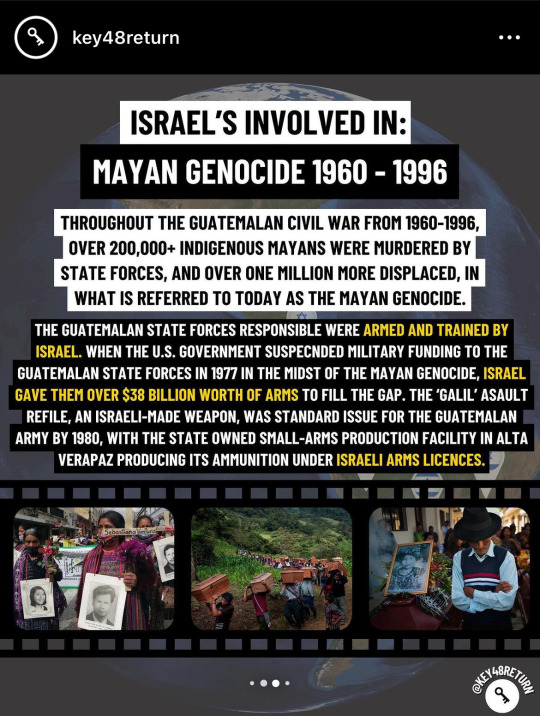
ID 4: In all caps, “ISRAEL'S INVOLVED IN:
MAYAN GENOCIDE 1960 - 1996
THROUGHOUT THE GUATEMALAN CIVIL WAR FROM 1960-1996, OVER 200,000+ INDIGENOUS MAYANS WERE MURDERED BY STATE FORCES, AND OVER ONE MILLION MORE DISPLACED, IN WHAT IS REFERRED TO TODAY AS THE MAYAN GENOCIDE.
THE GUATEMALAN STATE FORCES RESPONSIBLE WERE ARMED AND TRAINED BY ISRAEL. WHEN THE U.S. GOVERNMENT SUSPENDED MILITARY FUNDING TO THE GUATEMALAN STATE FORCES IN 1977 IN THE MIDST OF THE MAYAN GENOCIDE, ISRAEL GAVE THEM OVER $38 BILLION WORTH OF ARMS TO FILL THE GAP. THE 'GALIL' ASAULT RIFLE, AN ISRAELI-MADE WEAPON, WAS STANDARD ISSUE FOR THE GUATEMALAN ARMY BY 1980, WITH THE STATE OWNED SMALL-ARMS PRODUCTION FACILITY IN ALTA VERAPAZ PRODUCING ITS AMMUNITION UNDER ISRAELI ARMS LICENCES.”
Below are multiple in-color photos of Mayan families mourning, one photo in particular which shows indigenous Mayans carrying a seemingly endless line of coffins off into the distance. End ID.
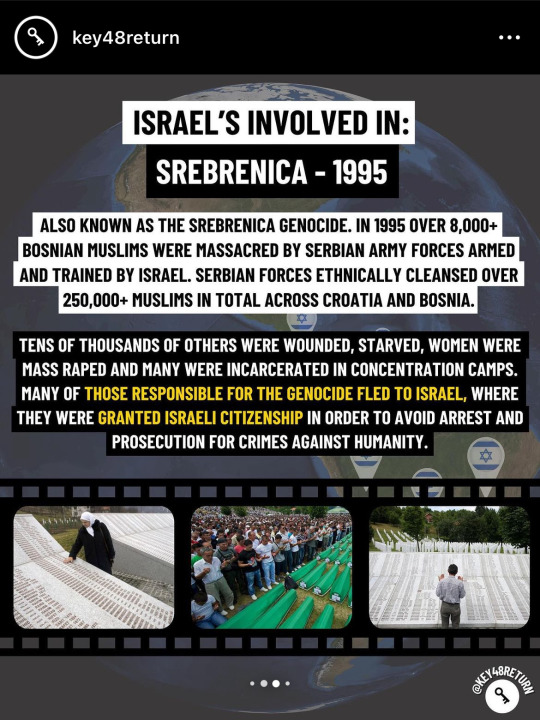
ID 5: In all caps, “ISRAEL'S INVOLVED IN:
SREBRENICA - 1995
ALSO KNOWN AS THE SREBRENICA GENOCIDE. IN 1995 OVER 8,000+ BOSNIAN MUSLIMS WERE MASSACRED BY SERBIAN ARMY FORCES ARMED AND TRAINED BY ISRAEL. SERBIAN FORCES ETHNICALLY CLEANSED OVER 250,000+ MUSLIMS IN TOTAL ACROSS CROATIA AND BOSNIA.
TENS OF THOUSANDS OF OTHERS WERE WOUNDED, STARVED, WOMEN WERE MASS RAPED AND MANY WERE INCARCERATED IN CONCENTRATION CAMPS. MANY OF THOSE RESPONSIBLE FOR THE GENOCIDE FLED TO ISRAEL, WHERE THEY WERE GRANTED ISRAELI CITIZENSHIP IN ORDER TO AVOID ARREST AND PROSECUTION FOR CRIMES AGAINST HUMANITY.”
Once again, the in-color photos below show various peoples mourning. Two of the photos specifically show people reaching their hands out over extremely long lists of just names of people who have died. End ID.

ID 6: In all caps, “ISRAEL'S INVOLVED IN:
TRAINING U.S. POLICE
SINCE 1990, HUNDREDS OF AMERICAN POLICE OFFICERS, INCLUDING AGENTS FROM THE FBI, CIA AND IMMIGRATION AND CUSTOMS ENFORCEMENT (ICE), HAVE EITHER BEEN SENT TO ISRAEL THROUGH POLICE TRAINING EXCHANGES, OR ATTENDED SUMMITS WITHIN THE U.S. THAT WERE SPONSORED BY ISRAELI LOBBY ORGANISATIONS.
THE KNEE-TO-NECK 'RESTRAINT' THAT DEREK CHAUVIN MURDERED GEORGE FLOYD WITH, IS OFTEN USED BY ISRAELI POLICE AND SOLIDERS AGAINST PALESTINIANS.
BLACK LIVES MATTER.”
Photos below are in-color and show various B.L.M. protests. End ID.
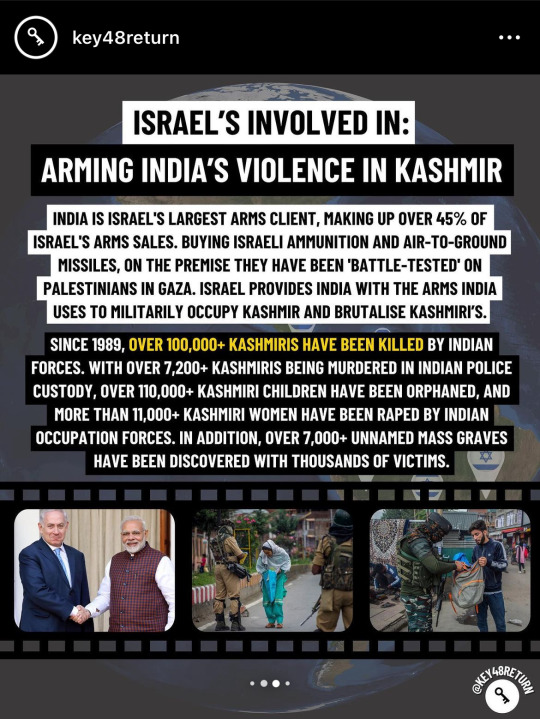
ID 7: In all caps, “ISRAEL'S INVOLVED IN:
ARMING INDIA'S VIOLENCE IN KASHMIR
INDIA IS ISRAEL'S LARGEST ARMS CLIENT, MAKING UP OVER 45% OF ISRAEL'S ARMS SALES. BUYING ISRAELI AMMUNITION AND AIR-TO-GROUND MISSILES, ON THE PREMISE THEY HAVE BEEN 'BATTLE-TESTED' ON PALESTINIANS IN GAZA. ISRAEL PROVIDES INDIA WITH THE ARMS INDIA USES TO MILITARILY OCCUPY KASHMIR AND BRUTALISE KASHMIRI'S.
SINCE 1989, OVER 100,000+ KASHMIRIS HAVE BEEN KILLED BY INDIAN FORCES. WITH OVER 7,200+ KASHMIRIS BEING MURDERED IN INDIAN POLICE CUSTODY, OVER 110,000+ KASHMIRI CHILDREN HAVE BEEN ORPHANED, AND MORE THAN 11,000+ KASHMIRI WOMEN HAVE BEEN RAPED BY INDIAN OCCUPATION FORCES. IN ADDITION, OVER 7,000+ UNNAMED MASS GRAVES HAVE BEEN DISCOVERED WITH THOUSANDS OF VICTIMS.”
The photos below show israel and india’s leaders shaking hands and various armed indian soldiers stopping Kashmiris for unnecessary checks. End ID.
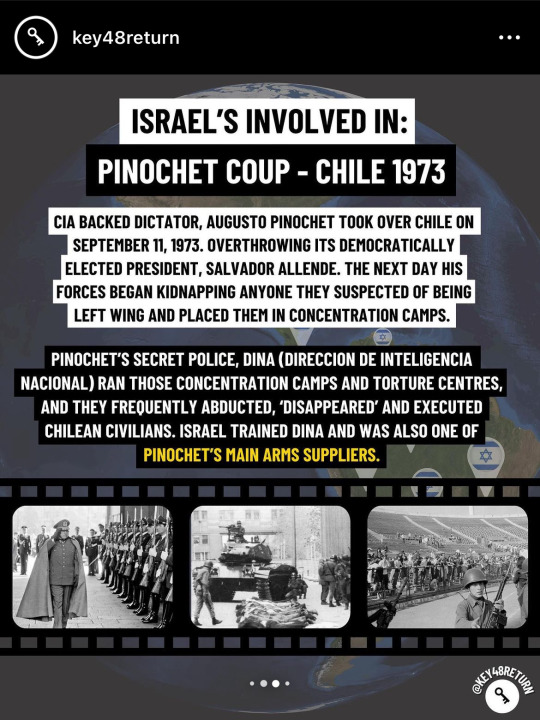
ID 8: In all caps, “ISRAEL'S INVOLVED IN:
PINOCHET COUP - CHILE 1973
CIA BACKED DICTATOR, AUGUSTO PINOCHET TOOK OVER CHILE ON SEPTEMBER 11, 1973. OVERTHROWING ITS DEMOCRATICALLY ELECTED PRESIDENT, SALVADOR ALLENDE. THE NEXT DAY HIS FORCES BEGAN KIDNAPPING ANYONE THEY SUSPECTED OF BEING LEFT WING AND PLACED THEM IN CONCENTRATION CAMPS.
PINOCHET'S SECRET POLICE, DINA (DIRECCION DE INTELIGENCIA NACIONAL) RAN THOSE CONCENTRATION CAMPS AND TORTURE CENTRES, AND THEY FREQUENTLY ABDUCTED, 'DISAPPEARED' AND EXECUTED CHILEAN CIVILIANS. ISRAEL TRAINED DINA AND WAS ALSO ONE OF PINOCHET'S MAIN ARMS SUPPLIERS.”
Black and white photos below showcase various scenes of armed DINA officers, with one photo in particular showing them in a tank over bodies on the ground, presumably dead. End ID.
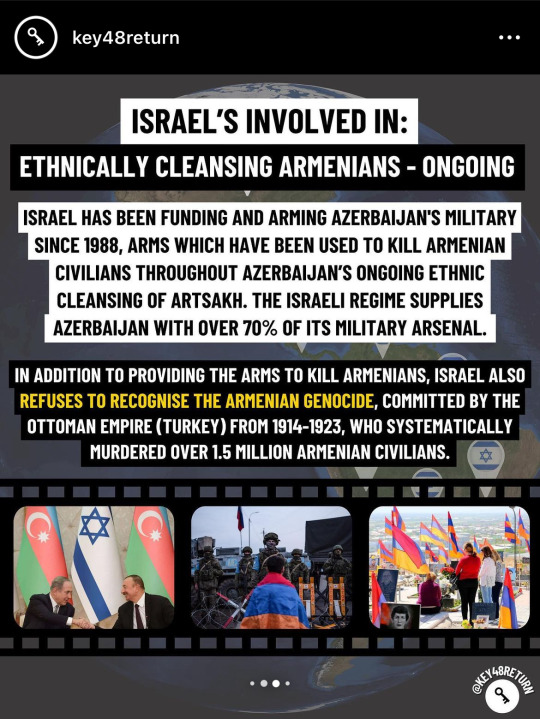
ID 9: In all caps, “ISRAEL'S INVOLVED IN:
ETHNICALLY CLEANSING ARMENIANS - ONGOING
ISRAEL HAS BEEN FUNDING AND ARMING AZERBAIJAN'S MILITARY SINCE 1988, ARMS WHICH HAVE BEEN USED TO KILL ARMENIAN CIVILIANS THROUGHOUT AZERBAIJAN'S ONGOING ETHNIC CLEANSING OF ARTSAKH. THE ISRAELI REGIME SUPPLIES AZERBAIJAN WITH OVER 70% OF ITS MILITARY ARSENAL.
IN ADDITION TO PROVIDING THE ARMS TO KILL ARMENIANS, ISRAEL ALSO REFUSES TO RECOGNISE THE ARMENIAN GENOCIDE, COMMITTED BY THE OTTOMAN EMPIRE (TURKEY) FROM 1914-1923, WHO SYSTEMATICALLY MURDERED OVER 1.5 MILLION ARMENIAN CIVILIANS.”
Photos below show israel and azerbaijan’s leaders shaking hands, azerbaijan’s soldiers menacingly standing in front of someone wrapped in an Armenian flag, and Armenians mourning over a shrine with their flags all around them. End ID.

ID 10: In all caps, “THE PALESTINIAN STRUGGLE FOR FREEDOM IS CONNECTED TO STRUGGLES ALL AROUND THE WORLD.
BECAUSE OPPRESSORS LIKE ISRAEL ARE NOT ONLY UPHOLDING OPPRESSION AGAINST ONE POPULATION, ITS ALWAYS INTERCONNECTED TO OPPRESSING MANY MORE.
FREE PALESTINE.” No photos at the bottom of this slide. End ID.
#reaux speaks#oppression#genocide#ethnic cleansing#apartheid#israel#palestine#free palestine#black lives matter#history#rwanda#africa#south africa#nelson mandela#mayans#guatemala#srebrenica#muslim#police brutality#kashmir#india#narendra modi#benjamin netanyahu#augusto pinochet#chile#armenia#artsakh#azerbaijan#bosnia#serbia
3K notes
·
View notes
Text
Something that honestly scares me is this maniacle belief that no one is allowed to have any joy or enjoy anything because bad things are happening in Gaza. Like people will disrupt anything fun or happy to make sure everyone is aware what's going on.
I've never seen suffering appropriation like this before. Not while Azerbaijan cleansed it's entire 400,000 person ethnic Armenian population, not while China enslaved and is still enslaving Uyghurs, not while there are genocides in Sudan, and Myanmar, and the ongoing hutu-tutsi fighting on the Rwanda/DRC boarder.
Literally every person knows what's happening in the middle east. It's been plastered on every screen for months. The idea that no one is allowed any joy because of that is baffling and counterproductive in so many ways
493 notes
·
View notes
Text
Ethnic cleansing? Genocide? Apartheid?
Throwing around these buzzwords to describe the Israel-Hamas war because you’ve seen them on social media doesn’t make you right, and it doesn’t make you an activist.
It makes you ignorant, intellectually dishonest, and lazy for parroting biased talking points with no concept about what these terms actually mean.
What is apartheid?
Well, it was first used to describe the political system in South Africa and today’s Namibia whereby racism was institutionalised. This manner of governance meant that clear racial segregation would occur, in a manner that benefited the white race and would actively oppress those who had darker skin.
This meant that there were white-only spaces, white people would get prioritised when it came to education and jobs, and relationships/marriages between white peoples and coloured people were illegal.
Is Israel objectively an apartheid state? There are no laws that actively favour one group over the other. There is a sizeable population of Israeli Arabs that can thrive in the same way as the Israeli Jews can. There are laws against discrimination on the basis of gender, race/ethnicity, and sexual orientation.
Palestinians from Gaza are allowed to work in Israel through a work permit system. There are about 150,000 Palestinians working in Israel, most of which live in Israel and some come from Gaza/the West Bank. They aren’t denied rights institutionally.
Is it harder to get a job or education in Israel if you’re a Palestinian from Gaza? Sure, because of different governments. It’s like how it’s a lot easier for you to find a job in your own country (in terms of paperwork and bureaucracy) than overseas. But you’re not denied the right to apply.
Of course, if you have a history of violence, a criminal record, or your family has ties to terrorists, then it’ll be a lot harder to get an approved work permit. But that’s not apartheid. That’s common sense, and a regulation practiced by all countries that minimally desire to protect their own population from danger.
Ethnic cleansing and genocide
These two concepts can go hand-in-hand. Ethnic cleansing refers to the mass expulsion or killing of a group of people based on their ethnicity. Similarly, genocide is the purposeful killing of a group of people solely with the intention of annihilating them.
Famous examples? The Holocaust, of course, where the Nazi regime believed in the superiority of the Aryan race and decided to declare genocide on the Jews, Romanis, the LGBTQ+ community, people with disabilities, people with “Asian features”, and many many other groups. Anyone who they didn’t think was “pure”.
Their aim was to ensure that the Aryan race propagated without having “impure” blood affecting the bloodlines. They even started a eugenics programme called Lebensborn to ensure that more pure Aryan babies were born.
More recent examples? The Rwandan genocide where the Hutus attempted to wipe out the Tutsis on the basis of ethnicity. They mandated that Tutsis mention their ethnicity on state-issued ID cards in order for the Hutus in power to be able to identify them and then kill them.
Or the Yazidi genocide which happened so recently, in which ISIL killed, raped, and sent thousands of Yazidis into conversion camps on the basis of their ethnicity. They also took Yazidi women as sex slaves and raped and tortured them.
Or the Rohingya Muslims in the Rakhine State in Myanmar, and how there was a mass killing and expulsion of them from the country, forcing them to flee to Bangladesh to take refuge, crating the world’s largest refugee camp.
Or how ISIS killed thousands of people from Christian groups in Iraq, Syria, Egypt, and Libya because of their faith, leading the US, EU, and UK to label this as religious genocide and condemned their actions.
Has Israel been practicing ethnic cleansing and genocide on Palestinians all these years?
Well, the birth rate of the Palestinian population in Gaza, the West Bank, and in Israel has been steadily increasing all these years.
So, no. No ethnic cleansing, no genocide. They are free to have as many children as they desire.
The UN Genocide Convention
The United Nations has 5 actions that constitute genocide.
1. Killing members of a target group
Israel is targeting Hamas officials with the aim of wiping out the terrorist group and ensuring that such a deadly attack on Israeli soil doesn’t happen again. I suppose you could call it genocide against Hamas, but they’re killing Hamas because they’re terrorists, not because they’re Palestinian. Shouldn’t everyone believe in genocide against terrorists?
But look at Black Saturday. Look at Hamas’ rhetoric. They repeatedly call for the annihilation of Israel and genocide of Jews. When will the media start believing what they say, word for word, instead of trying to spin it into “hmm maybe they want to kill all the Jews because they’re freedom fighters!”
War has collateral damage. Of course the innocent civilians don’t deserve to suffer just because of the actions of their government, but there have been warnings given to the Palestinian civilians prior to Israel striking the areas. There are consequences of attacking a country first, and then having that country attack you back.
2. Causing people of the group serious bodily or mental harm
The UN refers to sexual violence as the prime example of non-fatal harm.
Sexual violence has occurred. Hamas have kidnapped and raped women and even paraded the bodies of half-naked women around. But I f Israel had done the same, it’ll be the first thing appearing on everyone’s BBC push notifications (without even being confirmed as true).
3. Imposing living conditions intended to destroy the group
Many people refer to the blockade that Israel imposed around the Gaza Strip as an example of this.
This blockade was imposed by both Israel and Egypt in 2005. Its aim was to prevent smuggling of weapons into Gaza, and isolate the reign of Hamas to the region. This was to ensure the safety of Israel and Egypt.
Did this blockade pose serious challenges to the Gazan civilians? Of course. But that’s a consequence of having a terrorist government. If you have a terrorist group running your country, don’t be surprised if neighbouring countries are extra careful about who or what they allow in or out of the borders.
Many authorities from other Arab nations have also expressed approval of Egypt’s border restrictions, and even encouraged Egypt to flood the terror tunnels that Hamas has dug under the city. As a side note, other Arab nations have not historically been very kind or welcoming to Palestinians. Syria has killed over 4000 Palestinians, and many Arab countries are now refusing any refuge for Palestinians. But no one cares about that because it doesn’t make Israel look bad. All they do now is use the images of dead Palestinians under the hands of Syria and reuse them to propagate fake news.
The blockade has been labelled as a human rights violation because of collective punishment. Many humanitarian organisations believe that the blockade has caused the Palestinian civilians disproportionate harm.
Contrary to popular belief, Israel isn’t disallowing humanitarian aid from coming through the borders. Fuel, food, hygiene products, clothes, and shoes have been coming through the borders regularly for years. The Gaza Strip also has electricity and internet access and water.
Do all these items reach the Palestinian civilians? Well, there has been evidence that Hamas has been intercepting a lot of the supplies sent by humanitarian groups. This is not surprising since the UNRWA tweeted that Hamas has stole fuel from hospitals in Gaza in order to launch more rockets at Israel (but quickly deleted it after realising that it goes against their agenda to paint Hamas in a bad light.) In addition, the returned hostages have mentioned that there are many aid supplies hidden in the terror tunnels by Hamas. Instead of giving them to the civilians, they are hoarding it for themselves.
There has also been video evidence that some people are reselling these aid items in stores at exorbitant prices in order to turn profits. This has been well-documented for the last 10 years.
Is blockading the region to mitigate terrorism a disproportionate response? Well, it’s like asking if heightened security and stricter border control at airports is a disproportionate response after 9/11. Is being cautious and worrying about the security of your country an irrational reaction to the constant threat of terrorism?
4. Preventing births
Gaza’s population growth rate per annum is about 1.99%, which is the 39th highest in the world! Their population is allowed to propagate freely.
Israel isn’t preventing births of Palestinian babies.
5. Forcibly transferring children out of the group
No, Israel hasn’t been taking Palestinian children and forcing them to convert/keeping young Palestinian girls as sex slaves. Like I said, if this was truly happening, all the news outlets would be so quick to publish the story before verifying it.
Can we trust the UN Genocide standards?
The UN is known for corruption and have been exploiting the Palestinian people by selling them the humanitarian supplies instead of distributing them for free, which they should because these supplies literally are donations.
The UN also has differing standards of what they would label as genocide. For example, they refuse to call what China is doing to the Uyghurs in Xinjiang as genocide, even though the situation does fit many of their own criteria.
Hence, to all of you out there overusing these terms without knowing what they mean, make up your own mind about things. No one can force you to believe anything and no one can force you to change your mind.
But at the very least, do your due diligence and educate yourself before spouting tired buzzwords. Repeating misinformation doesn’t help anyone and can be very harmful.
#i stand with israel#israel#palestine#gaza#stop hamas#pro israel#am yisrael chai#hamas#fuck hamas#hypocrisy#i support israel#using buzzwords doesn’t make you smart#do your homework#do your own research#unrwa is a scam#make up your own mind#reading Al Jazeera headlines isn’t education#media bias#call out fake news#stop fake news#stop anti semitism
1K notes
·
View notes
Text
Masisi congolais dans des années 1885
Beaucoup d’encre, de salive et de sang coule dans le Masisi congolais depuis bien avant l’indépendance du Congo. Nous avons posé à Copilot la question de savoir qui occupait le Masisi dans le Kivu congolais en 1885 ? Contrairement à ce que attend souvent dire, les tutsi y auraient été à cette époque déjà. En 1885, le territoire de Masisi dans la région du Kivu congolais était habité par…
View On WordPress
1 note
·
View note
Text
5 février : la journée de l’unité nationale au Burundi
Le 5 février est un jour férié au Burundi, en mémoire de la charte de l’unité nationale signée le 5 février 1991. La Journée de l'Unité a été instaurée par le président Pierre Buyoya dans le but de réconcilier les groupes ethniques en guerre Tutsi et Hutu. En 1972, des massacres de Hutus avaient été perpétrés par une armée à majorité tutsie.
Malheureusement cette charte n’a pas écarté tout risque de génocide. En 1993, des extrémistes tutsis ont assassiné Melchior Ndadaye, le premier président hutu démocratiquement élu du pays. Ce meurtre a déclenché des massacres de Tusis par la majorité hutue et une guerre civile burundaise qui n’a officiellement pris fin qu’en 2005. Le pays a, à nouveau, connu une crise sanglante en 2015…
En dépit de ces drames, le jour de l’unité n’a jamais cessé d’être célébré. Cette année pour le 33e anniversaire de la charte, les cérémonies se déroulent au monument de l'unité nationale sur la colline Vugizo.
Un article de l'Almanach international des éditions BiblioMonde, 4 février 2024
0 notes
Text
The Dark Side of Rwanda's Kigali Convention Center and BK Arena

View On WordPress
0 notes
Text
I hate it when people compare the n-word with mudblood. I don't know if black people feel that way but I feel extremely offended as a person whose country is based on black folk slavery.
Like that n-word has such a deep rooted hatred of a history to the point it is basically still going on. People were yanked out of their homes by their own people (majority) and white people (sometimes), or hunted down. Brought to the shores then sold to the white folks for items to hunt more black people down.
Meanwhile white people began sharing the continent, drawing lines through homes, uncaring for the cultures within their self-proclaimed assigned country thus not caring if they clash or not. That until today, there are the tribes Hutus and tutsis that had a genocidal war not more than 30 years ago because white people back then shoved them together, apparently loved one tribe more than the other that the resentment was still deeply rooted.
On the shores their families got separated often. On the way to the other continents, many slaves were raped, starved and simply thrown overboard if they died due to horrid shipment conditions whilst surviving being packed like sardines in the bottom part of the boat without any bathroom. So blood, sperm, piss and shit was what they slept on.
When the survivors eventually do get on the other side, they are sold at an auction. Then branded by owners like cattle to be recognized by them easier. Older and sick folks were treated like the trash of the batch. Once the slaves eventually get on the plantation their work is harsh. Because they work in hot areas, such as tropicals or southern part of USA.
Children as young as possible (3yrs old) are placed into work. Slaves worked tirelessly for 6 days and if they worked with certain items such as sugarcane crusher/grinder and a limb is caught into it. An arm I lost or amputated. They get beaten to death for mistakes, orphaning their kids. They were raped if their master felt like it.
If the master was even more shallow, they would force two slaves copulate to make more free slaves for them. They saw the slaves as shed tool, treated them like cattle and so many more atrocities. Those same people gave slaves the n-word. To state the slaves as matter of factly as the n-word. The "cattle" is the n-word. The "tools" are the n-word.
That is the history of the n-word. Centuries of suffering, racism, pain, genocide, dehumanization and rape. So what in fuck's name does n-word have to be compared to a goddamn mudblood.
Were mudbloods hunted by witches/wizards?
Were mudbloods raped by witches/wizards?
Were mudbloods put to work tirelessly by witches/wizards?
Were mudbloods their children taken by witches/wizards?
Were mudbloods shipped by witches/wizards?
Were mudbloods their countries taken over by witches/wizards?
Were mudbloods branded by witches/wizards?
Were mudbloods whipped until death by witches/wizards?
Were mudbloods amputated by witches/wizards?
Were mudbloods their children placed on the working field by witches/wizards?
No, on the contrary witches/wizards kept their identity save from the muggles. Voldemort may or may not have been planning to do this. Because he wishes to rid muggles but maybe he didn't want to take all the extra steps white folks took back then. Also, Voldemort didn't care about ridding the world of muggles eventually. Becoming absorbed in attaining immortality.
So how about not comparing an actual event of genocide that lies on that word, with a fictional world that didn't even go through half as much as actual slaves did and get on with the day. Next time someone says "Severus said mudblood, same as saying the n-word. Would you accept the n-word?" I'll slap them across with this list.
First it's Nazi now n-word. Just shut the fuck up and let me do the reasonable talking here, fucking brat.
70 notes
·
View notes